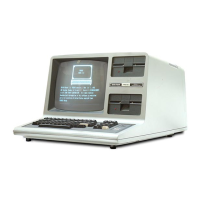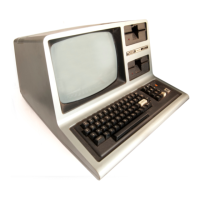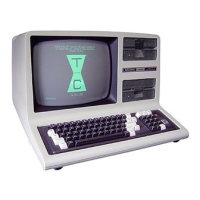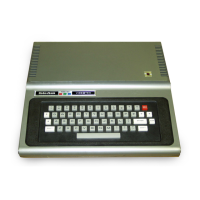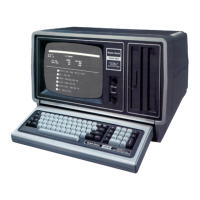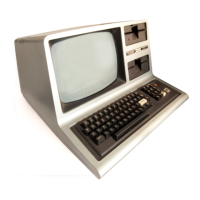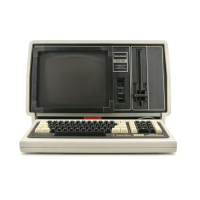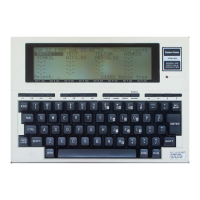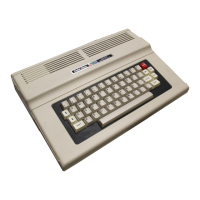Do you have a question about the Radio Shack TRS-80 PC-4 and is the answer not in the manual?
Customer responsibility for hardware/software meeting needs and operating environment.
Warranty terms for equipment and software, exclusions, and limitations.
Limits Radio Shack's liability for damages arising from equipment/software use.
Safety guidelines covering handling, environment, maintenance, and general use of the computer.
Instructions for replacing the computer's power source, including battery type and schedule.
Details the operations of keys and how they function in different modes (Shift In/Out).
Explains the SHIFT and MODE keys for accessing functions and changing settings.
Covers Cursor, AC (All Clear/ON), and DEL/INS keys for control and editing.
Explains the STOP and EXE keys for program execution management.
Covers ANS, Numerical, Calculation Instruction, EXP/PI, and Equal/Comparison keys.
Explains the components and indicators of the computer's display screen.
Instructions on how to adjust the display contrast using the side control.
Details the optional RAM expansion pack, its capacity increase, and installation procedure.
Explains how memory units and program steps are converted and expanded.
Describes the automatic power-saving feature and how it functions.
Explains the order of operations used in calculations, including functions and parentheses.
Details the capacity and display limits for input numbers and calculation results.
Provides guidance on using calculation symbols and available function commands.
Explains how to recall and reuse previous calculation results using the ANS key.
Lists common error codes, their meanings, and potential causes for calculations.
Details how to input alphabets, numbers, and symbols using the keyboard.
Demonstrates how to input various symbols using key combinations and modes.
Explains how to input numbers in scientific notation using the exponential key.
Provides methods for editing previously entered data on the screen.
Explains how to remove characters or parts of text using the DEL key.
Details how to insert new characters or spaces into existing input.
Defines manual calculation as distinct from programmed calculations.
Explains how to perform basic arithmetic, functions, and use variables.
Provides examples of addition, subtraction, multiplication, and division.
Demonstrates using memory functions for calculations and storing results.
Explains how to use trigonometric and logarithmic functions with examples.
Covers additional functions like square root, SGN, random numbers, and rounding.
Explains how to set the display format for numbers using the SET command.
Defines programming, programs, and their basic components like commands and operands.
Explains how to calculate the memory steps used by program commands and line numbers.
Differentiates between constants, numerical variables, and character variables used in programming.
Explains the syntax and meaning of substitution statements (variable = expression) in BASIC.
Details the steps for entering programs, including mode, area, and line input.
Step-by-step procedure for writing programs, including mode, area, and line input.
Explains the methods for running a written program, including area designation and RUN command.
Covers how to provide input during program execution using INPUT and KEY functions.
Covers methods for modifying, adding, or deleting lines within a program.
Details how to modify specific characters or parts of a program line.
Explains how to replace an entire program line with new code.
Covers how to insert new lines of code between existing lines in a program.
Covers methods for removing program lines or parts of lines.
Details how to delete specific characters or segments from a program line.
Explains how to remove an entire line of code from a program.
Describes how to change the line numbers of existing program lines.
Introduces methods for finding and fixing errors in programs.
Outlines the two main types of debugging: table top and conversation type.
Explains how to debug programs by analyzing error messages and conversing with the display.
Covers techniques for debugging by stopping execution or tracing line by line.
Details how to use the STOP command to pause program execution for inspection.
Explains how to use the TR mode for step-by-step program execution and debugging.
Lists and explains various commands used in programming the computer.
Explains the INPUT statement for receiving data during program execution.
Explains how the PRINT statement and CSR function control output display location.
Details the GOTO statement for controlling program flow by jumping to specific lines or areas.
Explains the IF statement for conditional branching based on comparisons.
Covers the FOR-NEXT statement for repeating operations a specified number of times.
Illustrates nesting of FOR-NEXT loops within each other.
Explains the GOSUB and RETURN statements for calling and returning from subroutines.
Discusses stacking of GOSUB statements, similar to FOR-NEXT loops.
Explains how to combine multiple commands on a single line using a colon.
Details the STOP statement for temporarily halting program execution.
Explains the END statement for permanently terminating program execution.
Covers the RUN command for executing programs or specific lines.
Explains how to display program code using the LIST command in different modes.
Details the MODE command for setting angular units or printer output conditions.
Explains the SET command for designating display output format (effective positions, decimal places).
Covers character manipulation functions like LEN, MID, and VAL.
Explains the VAL function for converting character strings to numerical values.
Details the VAC command for clearing all variable data.
Explains the CLEAR and CLEAR A commands for erasing programs.
Covers options related to cassette tape operations for program and data storage.
Introduces using cassette tapes for recording and loading programs and data.
Instructions for saving programs onto cassette tape using the SAVE command.
Instructions for loading programs from cassette tape using the LOAD command.
Explains how to save all programs from all areas to tape.
Explains how to load all programs from tape.
Details how to record variable data onto cassette tape.
Explains how to load variable data from cassette tape.
Describes the VER command for verifying recorded programs or data.
Covers connecting and using an optional printer for output.
Instructions on how to print program lists using the PRT mode.
Details commands related to loop structures like FOR-NEXT.
Covers commands for stopping/ending program execution and flow control.
Explains commands for clearing data and programs.
Details commands for setting angular units and output formats.
Details fundamental, built-in calculation functions and their ranges.
Covers commands, program functions, capacity, steps, and memory.
Describes the program system, language, stacks, and display contents.
Specifies display elements, main components, and power information.
Lists conditions under which Radio Shack may refuse service or void warranties.
Customer responsibility for hardware/software meeting needs and operating environment.
Warranty terms for equipment and software, exclusions, and limitations.
Limits Radio Shack's liability for damages arising from equipment/software use.
Safety guidelines covering handling, environment, maintenance, and general use of the computer.
Instructions for replacing the computer's power source, including battery type and schedule.
Details the operations of keys and how they function in different modes (Shift In/Out).
Explains the SHIFT and MODE keys for accessing functions and changing settings.
Covers Cursor, AC (All Clear/ON), and DEL/INS keys for control and editing.
Explains the STOP and EXE keys for program execution management.
Covers ANS, Numerical, Calculation Instruction, EXP/PI, and Equal/Comparison keys.
Explains the components and indicators of the computer's display screen.
Instructions on how to adjust the display contrast using the side control.
Details the optional RAM expansion pack, its capacity increase, and installation procedure.
Explains how memory units and program steps are converted and expanded.
Describes the automatic power-saving feature and how it functions.
Explains the order of operations used in calculations, including functions and parentheses.
Details the capacity and display limits for input numbers and calculation results.
Provides guidance on using calculation symbols and available function commands.
Explains how to recall and reuse previous calculation results using the ANS key.
Lists common error codes, their meanings, and potential causes for calculations.
Details how to input alphabets, numbers, and symbols using the keyboard.
Demonstrates how to input various symbols using key combinations and modes.
Explains how to input numbers in scientific notation using the exponential key.
Provides methods for editing previously entered data on the screen.
Explains how to remove characters or parts of text using the DEL key.
Details how to insert new characters or spaces into existing input.
Defines manual calculation as distinct from programmed calculations.
Explains how to perform basic arithmetic, functions, and use variables.
Provides examples of addition, subtraction, multiplication, and division.
Demonstrates using memory functions for calculations and storing results.
Explains how to use trigonometric and logarithmic functions with examples.
Covers additional functions like square root, SGN, random numbers, and rounding.
Explains how to set the display format for numbers using the SET command.
Defines programming, programs, and their basic components like commands and operands.
Explains how to calculate the memory steps used by program commands and line numbers.
Differentiates between constants, numerical variables, and character variables used in programming.
Explains the syntax and meaning of substitution statements (variable = expression) in BASIC.
Details the steps for entering programs, including mode, area, and line input.
Step-by-step procedure for writing programs, including mode, area, and line input.
Explains the methods for running a written program, including area designation and RUN command.
Covers how to provide input during program execution using INPUT and KEY functions.
Covers methods for modifying, adding, or deleting lines within a program.
Details how to modify specific characters or parts of a program line.
Explains how to replace an entire program line with new code.
Covers how to insert new lines of code between existing lines in a program.
Covers methods for removing program lines or parts of lines.
Details how to delete specific characters or segments from a program line.
Explains how to remove an entire line of code from a program.
Describes how to change the line numbers of existing program lines.
Introduces methods for finding and fixing errors in programs.
Outlines the two main types of debugging: table top and conversation type.
Explains how to debug programs by analyzing error messages and conversing with the display.
Covers techniques for debugging by stopping execution or tracing line by line.
Details how to use the STOP command to pause program execution for inspection.
Explains how to use the TR mode for step-by-step program execution and debugging.
Lists and explains various commands used in programming the computer.
Explains the INPUT statement for receiving data during program execution.
Explains how the PRINT statement and CSR function control output display location.
Details the GOTO statement for controlling program flow by jumping to specific lines or areas.
Explains the IF statement for conditional branching based on comparisons.
Covers the FOR-NEXT statement for repeating operations a specified number of times.
Illustrates nesting of FOR-NEXT loops within each other.
Explains the GOSUB and RETURN statements for calling and returning from subroutines.
Discusses stacking of GOSUB statements, similar to FOR-NEXT loops.
Explains how to combine multiple commands on a single line using a colon.
Details the STOP statement for temporarily halting program execution.
Explains the END statement for permanently terminating program execution.
Covers the RUN command for executing programs or specific lines.
Explains how to display program code using the LIST command in different modes.
Details the MODE command for setting angular units or printer output conditions.
Explains the SET command for designating display output format (effective positions, decimal places).
Covers character manipulation functions like LEN, MID, and VAL.
Explains the VAL function for converting character strings to numerical values.
Details the VAC command for clearing all variable data.
Explains the CLEAR and CLEAR A commands for erasing programs.
Covers options related to cassette tape operations for program and data storage.
Introduces using cassette tapes for recording and loading programs and data.
Instructions for saving programs onto cassette tape using the SAVE command.
Instructions for loading programs from cassette tape using the LOAD command.
Explains how to save all programs from all areas to tape.
Explains how to load all programs from tape.
Details how to record variable data onto cassette tape.
Explains how to load variable data from cassette tape.
Describes the VER command for verifying recorded programs or data.
Covers connecting and using an optional printer for output.
Instructions on how to print program lists using the PRT mode.
Details commands related to loop structures like FOR-NEXT.
Covers commands for stopping/ending program execution and flow control.
Explains commands for clearing data and programs.
Details commands for setting angular units and output formats.
Details fundamental, built-in calculation functions and their ranges.
Covers commands, program functions, capacity, steps, and memory.
Describes the program system, language, stacks, and display contents.
Specifies display elements, main components, and power information.
Lists conditions under which Radio Shack may refuse service or void warranties.
| Model | TRS-80 PC-4 |
|---|---|
| Category | Desktop |
| Manufacturer | Radio Shack |
| Release Year | 1983 |
| Display | LCD, 1 line |
| Ports | Expansion port |
| Power Supply | AC Adapter |

